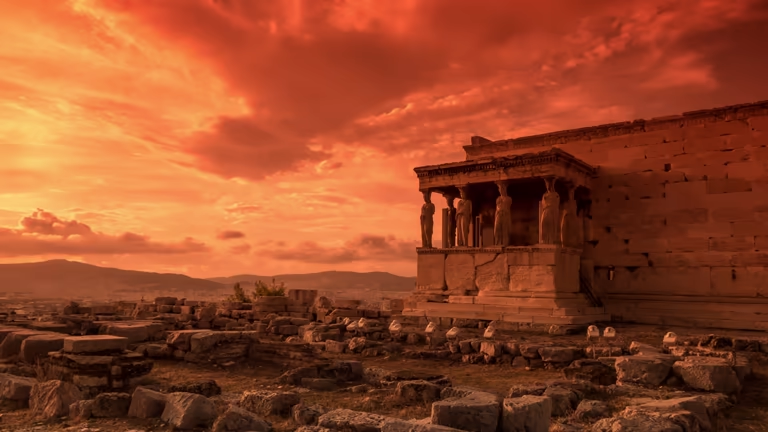For centuries, Antarctica has stood like a silent, frozen sentinel at the bottom of the world—a land of icy mystery and scientific enigma. This continent, wrapped in myth and cloaked in perpetual snow and ice, is unlike any other place on Earth. It is a vast white void where temperatures plunge to extremes and the winds howl across glacier-strewn deserts. Yet beneath the sheer, otherworldly desolation, Antarctica might hide secrets far stranger than penguins or polar storms.
Could there be ancient cities buried deep beneath its ice sheets—forgotten remnants of a pre-glacial civilization? This question, once the domain of science fiction and fringe theorists, has gained a strange new traction. From tantalizing satellite images and sudden archaeological discoveries in nearby regions, to intriguing scientific data suggesting past temperate climates, the idea is being revisited by both adventurers of thought and frontier scientists.
This article will take you on a deep dive into one of the most provocative mysteries of our time. Are we standing on the brink of uncovering lost chapters of human history frozen under the coldest continent on Earth?
The Ice Enigma: Antarctica’s True Nature
Before we chase rumors of ancient ruins, it’s important to understand what makes Antarctica so fascinating and so challenging. Antarctica is not just a continent—it’s an archive of Earth’s climatic past. It is the driest, windiest, coldest place on Earth, covered almost entirely by a massive sheet of ice that in some places is over 4 kilometers (2.5 miles) thick.
But it wasn’t always this way.
Millions of years ago, during the early Eocene epoch (around 56 to 34 million years ago), Antarctica was lush and green. Fossilized trees, leaf impressions, and pollen found in sediment cores suggest a temperate, forested land where dinosaurs once roamed and ferns flourished. Some regions may have experienced a subtropical climate, complete with fresh-water lakes and a thriving ecosystem.
What caused this paradise to freeze over? Tectonic drift gradually moved the continent south, breaking it away from warmer neighbors and allowing the circumpolar current to form. This cold oceanic flow isolated Antarctica, initiating a long freeze that culminated in the modern glacial era.
But here’s where things get strange.
Recent discoveries suggest that parts of Antarctica might have remained ice-free much longer than previously thought. The East Antarctic Ice Sheet, once believed to be ancient and unchanging, may have melted significantly as recently as 400,000 years ago. Could there have been a window, in the deep past, when humans—or pre-human civilizations—might have explored or even settled parts of the continent?
Legends and Lore: Ancient Memory or Myth?
The idea of a hidden land in the south dates back millennia. Greek philosophers speculated about Terra Australis Incognita—“the unknown southern land”—a theoretical balancing continent opposite the known world. Some 15th-century maps, such as the infamous Piri Reis map, seem to depict a southern landmass in curious detail, long before Antarctica was officially discovered in 1820.
These maps have sparked controversy for decades. The Piri Reis map, created in 1513 by an Ottoman admiral using earlier sources, shows what some interpret as an ice-free coastline resembling Queen Maud Land, a part of Antarctica. Could the mapmakers have had access to ancient charts passed down from lost civilizations?
Mainstream scholars are skeptical. Most believe the southern portions of these maps are artistic flourishes or misinterpretations of South America. But to proponents of ancient advanced civilizations—those who follow the ideas of Graham Hancock, Charles Hapgood, or Erich von Däniken—the maps are evidence of forgotten knowledge.
One of the most intriguing theories, proposed by Hapgood in the 1950s, is that of “Earth Crust Displacement.” According to this idea, the outer crust of the Earth can shift rapidly, moving entire continents from temperate to polar regions in mere millennia. He speculated that Antarctica was once home to a seafaring civilization that was buried in a sudden climate catastrophe. Albert Einstein even wrote a foreword to Hapgood’s book, calling the hypothesis “interesting and worthwhile.”
Scientific Curiosities: What Lies Beneath the Ice?
In recent decades, radar and satellite technology have offered an unprecedented look beneath Antarctica’s vast ice sheets. What scientists are finding is surprising—and in some cases, unsettling.
Lake Vostok: A Hidden World Below
One of the most enigmatic discoveries is Lake Vostok, a subglacial lake buried beneath 4,000 meters of ice. This lake, larger than Lake Ontario, has been sealed off from the atmosphere for perhaps 15 million years. When Russian scientists drilled down to the edge of the lake in the early 2000s, they raised tantalizing questions: Could unique forms of life exist in the dark, pressurized, and oxygen-deprived waters?
Initial samples revealed strange microbial life, sparking speculation about what else might survive in such an alien environment. If life can thrive here, perhaps structures or remnants of an ancient society could also be preserved in ice elsewhere—suspended in time, awaiting rediscovery.
Gamburtsev Mountains and Subglacial Topography
Beneath East Antarctica lies a range of mountains as large as the Alps—the Gamburtsev Mountains. These towering peaks were discovered by Soviet scientists in the 1950s but remained largely unexplored until modern radar mapping revealed their full extent. Hidden under miles of ice, these mountains are complete with valleys and ridges that suggest long-lost river systems.
Could such a region, before the ice settled, have harbored human life?
Geological data confirms that parts of the East Antarctic plateau were once ice-free and may have supported freshwater systems. Moreover, some radar images have shown curious formations—symmetrical shapes, rectilinear outlines—that hint at artificiality. Could these be ruins, or are they simply unusual rock formations carved by ancient rivers?
Magnetic Anomalies and Geometric Patterns
Further fueling speculation are magnetic anomalies detected in areas like Wilkes Land. In 2006, NASA scientists studying satellite gravity data noted a massive impact crater buried beneath the ice. The crater is over 300 miles wide and may be the result of a comet impact 250 million years ago, linked to the Permian-Triassic extinction.
But nearby, researchers found geometric patterns that some have interpreted as unnatural. Rectangular formations, concentric circles, and right-angled edges—if real—would be extremely unusual in nature. However, confirmation is difficult. Antarctica is fiercely guarded by extreme cold, logistical barriers, and international treaties that restrict exploration.
The Problem of Preservation
Skeptics argue that no human civilization could have existed on Antarctica in the past 100,000 years, given the continent’s glaciation timeline. Archaeologists contend that we’ve found no artifacts, no tools, no bones.
But consider this: ice is both a destructive and preservative force. On one hand, glaciers grind and crush, obliterating anything beneath them. On the other, if something were encased rapidly—such as during a sudden freeze—it could remain eerily intact. We have found woolly mammoths frozen with food still in their mouths. Entire Viking farms have been uncovered in Greenland under melting permafrost.
Moreover, much of Antarctica remains unexplored. Satellite data covers the surface, but the land beneath the ice has been directly mapped in only fragments. It is entirely plausible that entire regions remain hidden, waiting for the right tools—or thaw—to reveal them.
New Technologies and Renewed Interest
In recent years, new technologies have begun unlocking Antarctica’s secrets. Ice-penetrating radar, gravitational mapping, and drones capable of operating in subzero conditions are allowing scientists to peer deeper than ever before.
In 2018, scientists discovered nearly 100 previously unknown volcanoes beneath the Antarctic ice, raising new questions about geothermal heat flow and melting patterns. Could volcanic heat be keeping some regions warmer than we realize, potentially maintaining hidden ecosystems—or buried chambers—beneath the ice?
At the same time, climate change is accelerating the melting of Antarctic ice. While this is an environmental tragedy, it also presents an archaeological opportunity. Areas once inaccessible are becoming visible, and ancient coastlines are emerging from beneath retreating glaciers.
Could the next decade yield a discovery that rewrites history?
The Fringe and the Fantastic: UFOs, Nazis, and Ancient Builders
No discussion of hidden Antarctic cities would be complete without a glance at the wilder theories. Antarctica, perhaps more than any place on Earth, has become a magnet for conspiracy narratives.
Some believe that the Nazis established secret bases in Antarctica during World War II—specifically in Queen Maud Land, renamed by them as “Neuschwabenland.” These bases, the theory goes, housed advanced technologies, possibly acquired through contact with ancient knowledge or extraterrestrials. Operation Highjump, a 1946 U.S. Navy mission to Antarctica led by Admiral Richard Byrd, has been woven into these tales, with rumors suggesting it was a military effort to confront or locate the Nazi remnants.
Others claim that Antarctica is a gateway to inner Earth—a hollow realm where ancient beings, lost technologies, or aliens reside. These theories, while captivating, remain unsupported by hard evidence. Yet their popularity underscores a central human trait: our thirst for mystery and meaning.
What Would It Mean?
Let us indulge the possibility for a moment. Suppose a subterranean structure were discovered beneath the Antarctic ice—something unmistakably artificial, complete with inscriptions, stairways, or tools. What would it mean?
It would upend our understanding of human history. It would force a reevaluation of the timeline of civilization and perhaps even the origin of our species. Did humanity develop advanced knowledge earlier than we thought? Were there isolated branches of civilization we’ve forgotten?
And perhaps most importantly, it would serve as a humbling reminder: the story of Earth is far from complete, and the ice still holds secrets we’ve only begun to imagine.
Conclusion: A Continent of Possibility
Antarctica stands as a paradox—a place of lifelessness that may hold the echoes of life, a land of silence that might one day speak. While no irrefutable evidence of ancient cities has yet emerged from beneath its ice sheets, the clues are accumulating. The fossil record proves the land was once green. Geological data shows that parts of it were habitable in human-prehistory timeframes. And remote sensing technologies are revealing anomalies that beg further exploration.
Whether ancient cities truly lie buried in Antarctica, or whether the allure is merely a mirror of our longing for forgotten wisdom, one thing is certain: the last continent still has stories to tell. In its frozen depths may lie the next great revelation of our human saga—or the confirmation that even the wildest ideas can sometimes be closer to truth than we dare believe.
As exploration continues, as satellites scan, and as ice melts, we inch closer to answering one of the most compelling questions of our age: Are there ancient cities hidden beneath Antarctica’s ice?






